Take a shapely traditional boat, add an artist’s eye and a practical touch, update it for the way we live now, and you may have found tomorrow’s classic. This is the case for Iain Oughtred’s Acorn skiff. More than that, the design worked so well that it became a turning point for the creator’s career. Now in its seventh refinement, the Acorn, in its various sizes, remains one of Oughtred’s most popular designs. Acorns can be found from Oughtred’s native Australia to his adopted Britain, and from the West Coast of the United States to the East Coast, where its workboat roots are found. It will, no doubt, continue to be built for years to come.
Back when Oughtred first designed the boat in the early 1980s, he also compiled an annotated directory of wooden boat builders in Britain, finding some 300 around the country struggling with precious little encouragement. The directory and the boat helped raise awareness of wooden boats there. Maynard Bray, writing in WB No. 56, described the Acorn as an ideal lapstrake plywood boat for an amateur to build, “a sweet-lined, slippery little jewel.” The magazine also described her construction and has sold her plans ever since. “It gave me the funds and encouragement to continue [designing] when I might have stopped,” Oughtred reminisced.
The traditional type on which the Acorn is based is the Whitehall, which takes its name from Whitehall Street in New York City, where former Navy apprentices started building the type in the 1820s in the same general shape as pulling gigs or wherries. These boats had long, sharp bows, plank keels, rising floors, slack bilges, and flaring sides. “The after sections were slightly hollow at the garboards, and the transom was heart shaped,” historian Howard Chapelle wrote. Soon, they were built as stock boats and used by many people needing to move about America’s harbors, including ships’ chandlers, insurance adjusters, and pilots—and also for sailors going ashore to boarding houses and brothels. They rowed well and were sometimes sailed.
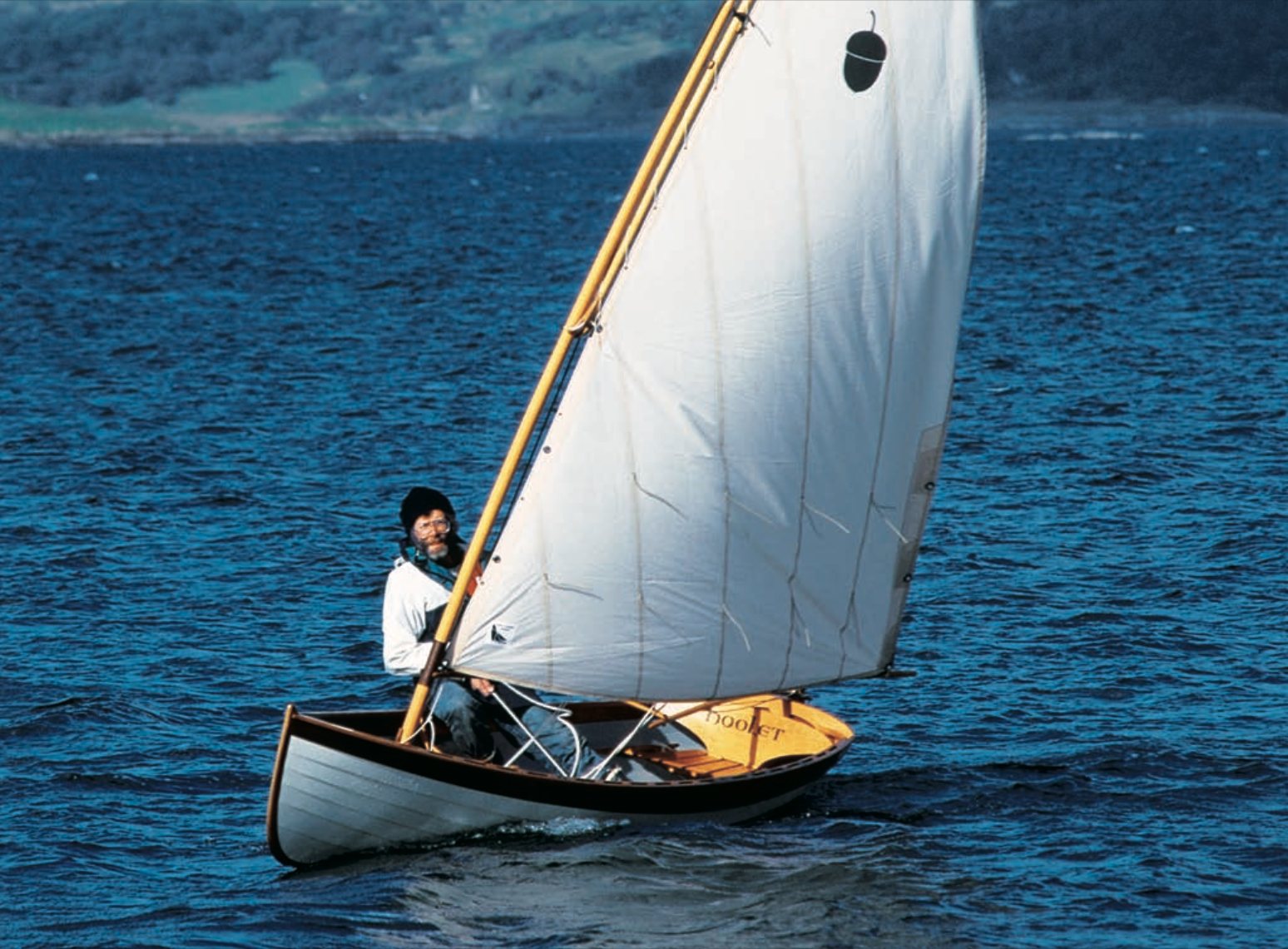 Photo by Kathy Mansfield
Photo by Kathy MansfieldDesigner Iain Oughtred’s Acorn 13 has evolved from a series of designs, starting with a 7′ 10″ dinghy. With his 11′ 8″ Acorn, he used a finer hull for rowing and sailing, and the 13′ version of the Acorn is simply the 11′ 8″ version stretched by spacing the construction molds a little wider.
Inspired by the refined Whitehall shape, Oughtred gave the Acorn skiff a clean entry, rounded bilges, a classic sheerline with beautifully tapered planks, and a wineglass transom. The shape of the sheer, with its low freeboard, provides two comfortable rowing positions, and the boat’s narrow waterline beam and lean hull sections aft under the transom’s curves give her good directional stability and a good turn of speed under oars.
By using epoxies and modern building methods, Oughtred’s plans stipulated very light construction. The lapped joints of her plywood strakes, when glued together, act like stringers, stiffening the hull longitudinally. With eight strakes per side and no frames or stringers, she’s light enough to be lifted on top of a car and transported. The knees and floors are laminated, so no steam-bending is necessary. Oughtred first designed an 11′ 8″ version, primarily as a rowing boat. With the Acorn 13, which is set up for both sailing and rowing, the forefoot is a little deeper and the transom smaller, and any loss in buoyancy aft is made up by having a longer boat where passengers can spread out. The designed building frame has been raised slightly, with molds shifted farther apart, making the building process easier, with just seven strakes a side. The plans, much revised, now include full-sized mold patterns so no lofting needs to be done. The beautifully drawn seven sheets of plans also give hull lines, a table of offsets, construction plans, sail plans, spar and rigging details, and drawings for both straight-and spoon-bladed oars. Detailed instructions and notes are included.
Oughtred suggests a nominal 1⁄4″ plywood for the hull, using okoume with mahogany or other hardwood outer veneers, or perhaps solid mahogany if a tougher hull is required. She can also be traditionally built, strip-planked, or cold-molded. Much of the complexity of a traditional boat has been cut out: she takes about 160 hours for an experienced person to build, with an additional 30 hours for the sailing version’s spars, daggerboard and trunk, and rudder.
I first saw an Acorn 13 skiff in Scotland, near Inverary on the banks of Loch Fyne, on a day when the blues and greens of the mountains shaded down to iridescent hues on the loch, and the water lapped on the pebbles of the beach across from a castle. A sailing skiff seemed to waft along on no breeze at all, and there was a spontaneous movement of people walking down from the lochside pub to have a look. The talk seemed to turn from boat construction to whisky, and it was only later that I learned that the boat had been built by students and Oughtred had fitted her out himself, making the floorboards, thwarts, spars, and other fittings from a very close-grained Douglas-fir that in its earlier life had been used to hold whisky in a Scottish distillery. Its golden color was perhaps partly the long, slow maturing of wood and whisky together.
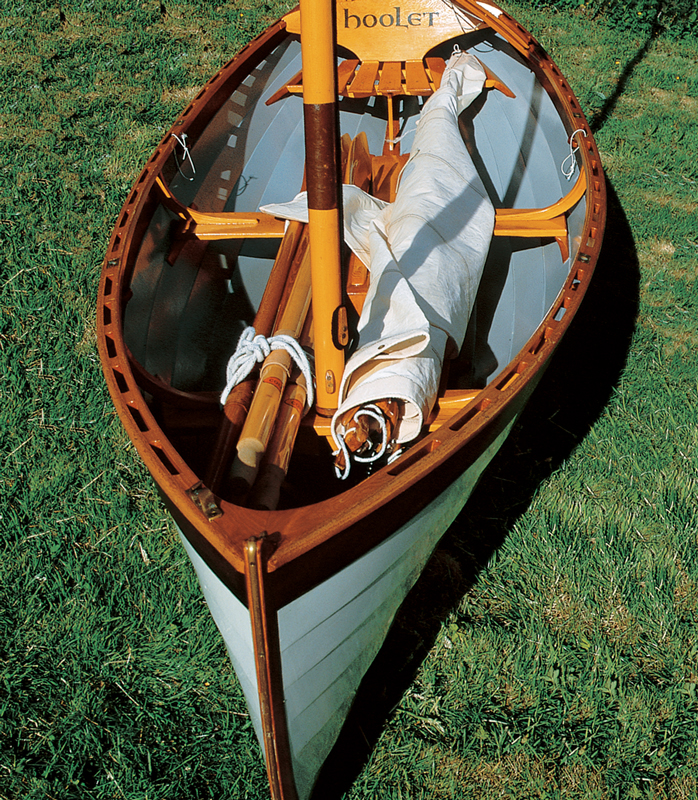 Photo by Kathy Mansfield
Photo by Kathy MansfieldPlywood lapstrake construction not only makes the boat lightweight buy also keeps the interior uncluttered and easy to clean.
The boat, named HOOLET, Gaelic for a little owl, looked perfectly at home on a loch, and her elegant, classic rig also packed in plenty of traditional detail. There were adjustable parrel beads on the jaws of her gunter spar, and the halyard and downhaul lines led down to belaying pins set in forward thwart, which supported the mast. I’d used belaying pins on a schooner and a medieval replica, but I found they worked fine on small skiffs, too.
The rudder fitted and lifted quickly, leaving a single-hander time to concentrate on the daggerboard in shallow waters: we were to find that very useful in a strong wind. But for the moment, there was little breeze, and even though four of us piled into a boat built for three, we ghosted along nicely, slipping past becalmed yachts and tacking almost under a bagpipe band playing on Inverary’s pier. With a sail area of 48 sq ft, she’s probably a bit overcanvased, but we were happy to have that extra power. She would have slipped along beautifully singlehanded. Her long, narrow waterline gave good directional stability but meant it was best not to put the helm over too quickly or too far when tacking, rather like her traditional forebears. There are several rigs to choose from in Iain’s designs: gunter, spritsail, and standing lug. All are fun to use and no doubt give the boat different sailing performances and characters.
There was another chance to sail HOOLET, this time after a night of rain and with a gale forecast for later in the day on the boisterous west coast of Scotland near Loch Melfort. First, I rowed her. She pulls beautifully, as mannered and elegant as the finest Thames skiff from farther south, quickly picking up speed and maneuvering neatly. But it would be a pity never to sail this boat. She can be well behaved with a small sail, a reef, or an extra passenger, but she came alive as we rounded the point into a very stiff breeze. She also proved Maynard Bray’s comment about the original Acorn skiff: “Make no mistake—she is neither particularly stable nor particularly burdensome. If you’re looking for a boat that you and your passengers can clomp around in, stay away from this one.” Oughtred suggested she’d suit retired Moth skippers in a good wind. Her round bilge meant that she was less stable when boarding her, but now she was up and flying, steady and responsive as long as you remembered not to spin her but to sail her around in a tack. Her clean interior made moving about easy, the crew sitting forward of the centerboard trunk. Iain is himself an excellent sailor, and his boats are built to his standards.
Only once have I succumbed to the danger of writing about beautiful boats—the danger being, of course, falling for the boat you have described. It was all about Oughtred’s Acorn 13. The feeling starts with a deep longing, subjective comparisons with alternatives, and eventually the checkbook comes out as another boat is added to the family fleet. There is always an excuse—and in this case it was like buying a work of art that had a practical use. Our daughter happened to be along at Inverary and was just the age to covet the control of her own boat. Plus, we lived near a river, not a lake, so a good rowing skiff would be ideal for summer evenings after work, with sailing a weekend option. The gunter rig would be easy for lowering under bridges. And what a jewel of a boat it is….

The Acorn 13 has the Whitehall type’s fine ends below the waterline and a lovely wineglass-shaped transom. To make the 13-footer, the 11′ 8″ version’s construction molds are simply spaced more widely. Sprit, lug, and gunter sail plans are available, each with identical sail area.
This Boat Profile was published in Small Boats 2008 and appears here as archival material. Plans are currently available from The WoodenBoat Store, P.O. Box 78, Brooklin, ME 04616; 800–273–7447; www.woodenboat.com.

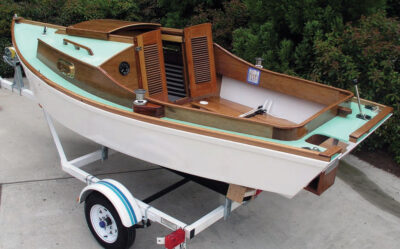
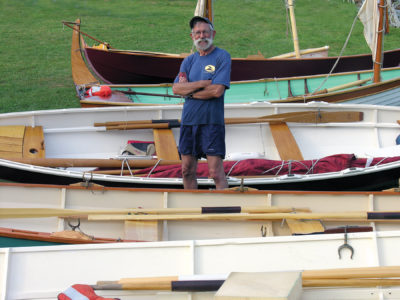
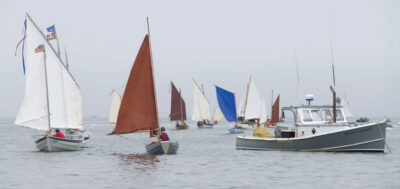
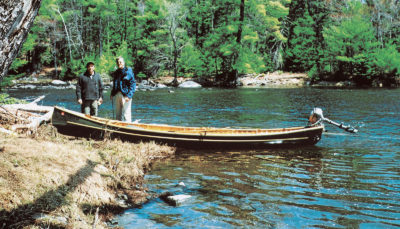
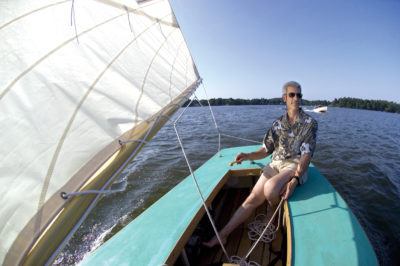
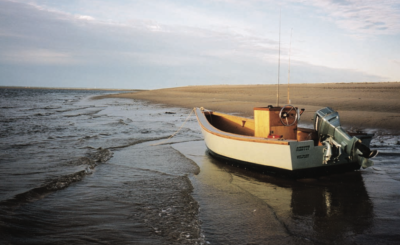
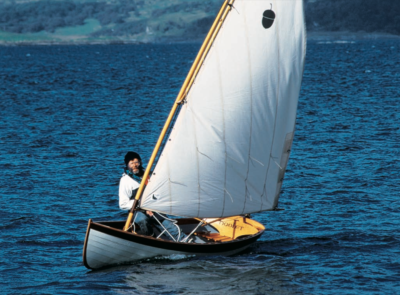
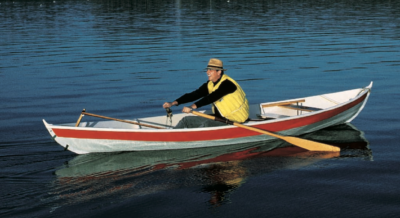
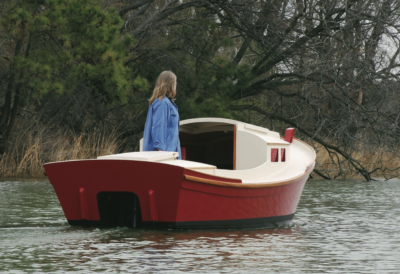
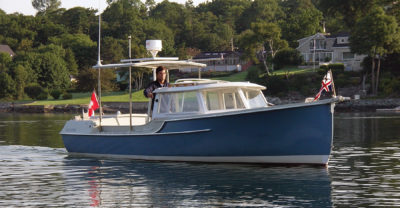
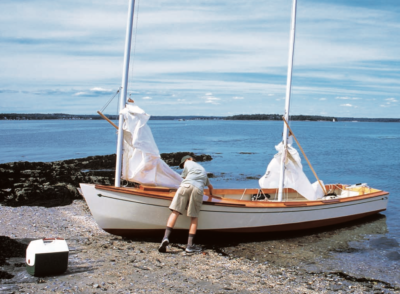
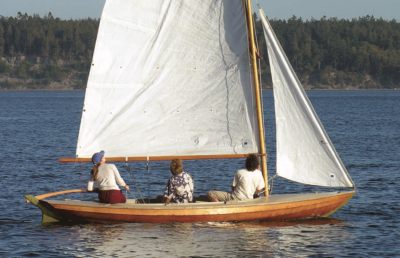
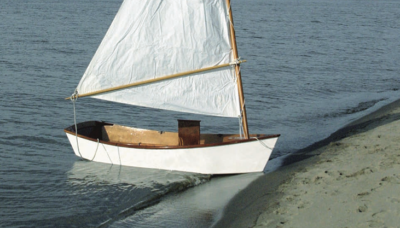
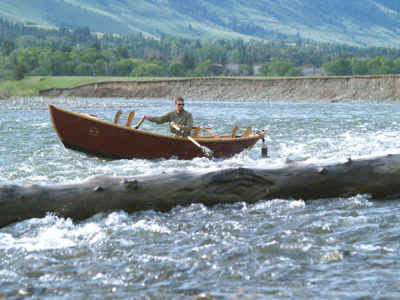

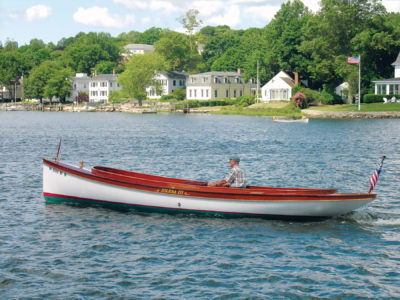
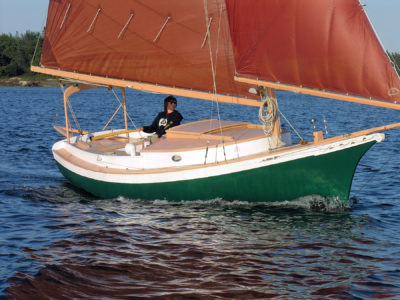
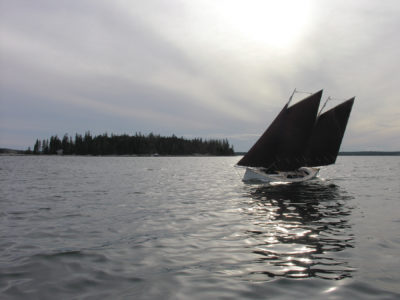
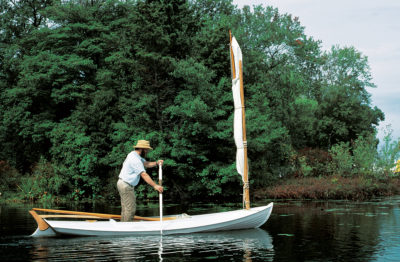
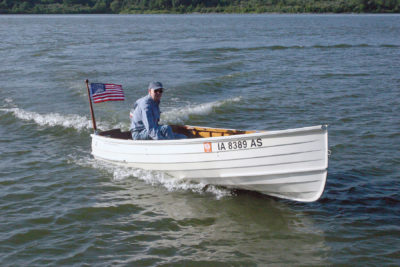
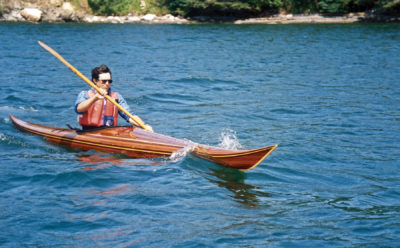
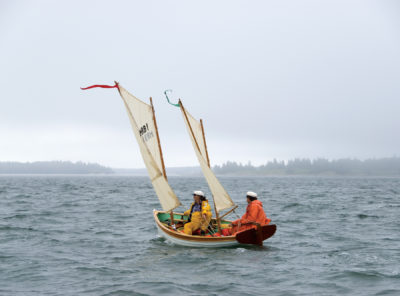

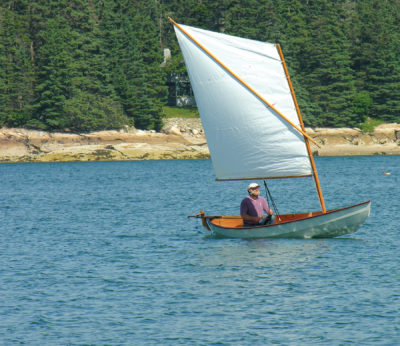

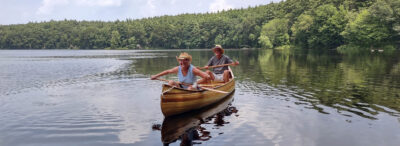
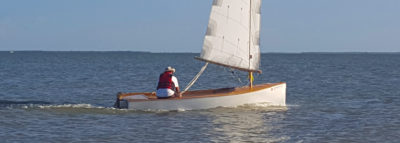
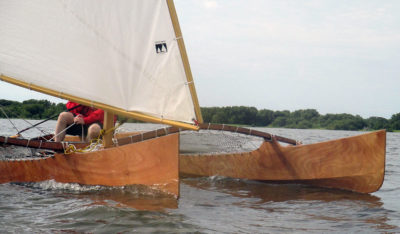
Looking for plans for a future build. Will definitely download study plans!
Is the Acorn available in a kit?
Dave Eckrich
Dave, you might have a look here – http://straydogboatworks.com/oughtred/mainpages/rowingskiffs.html
Hi,
I recently acquired a lovely Acorn 12 build by the Landing School in 2014. A lake and inshore sailer now and would like to modify the rudder from fixed to a folding one so not to damage it in shallow water, trailering, etc. Could build a new one, I guess, but would like to keep the original with just a folding mod. Guess I could cut the original, add 4mm cheeks, and a pivot point, but wondering if there are other mods that have been tried successfully.
Nice to see her Scottish roots as I served there in the late ’80s. Luv’er.
Rick